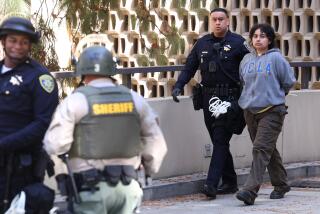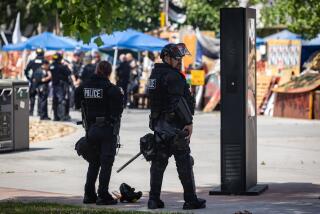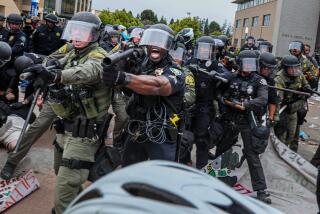Putting the move in Occupy movement
How will it end?
More than a month into the Occupy movement, officials are beginning to talk openly of moving protesters out of their encampments in parks and public squares around the country.
But many activists show no signs of budging as the movement continues to generate heavy media attention and support from liberal circles.
Looming large is the cautionary spectacle of Oakland. Police there arrested about 100 protesters before dawn Tuesday, using tear gas and riot gear to break up encampments — only to face a massive evening protest and threats of continued unrest from angry backers of the movement.
Leaders in other cities said they don’t want a repeat of that chaos, but it’s unclear how they will eventually oust protesters who refuse to leave.
Even in Los Angeles, where city leaders have greeted the demonstrators warmly, there are signs of protest fatigue and increasing anxiety about what happens next.
Los Angeles Mayor Antonio Villaraigosa, who earlier this month had ponchos distributed to rain-soaked Occupy L.A. protesters, said Wednesday that the encampment next to City Hall “cannot continue indefinitely.”
Villaraigosa has instructed city officials to draft a plan for another location for the demonstration. He decided the camp could not stay after Los Angeles County health inspectors expressed worries about the cleanliness of the camp, and because of concerns about the condition of the lawn and trees.
“Look, our lawn is dead, our sprinklers aren’t working . . . our trees are without water,” the mayor said.
Los Angeles City Atty. Carmen Trutanich, meanwhile, said police should enforce an existing law that keeps people from camping in city parks after 10:30 p.m. since they enforce it elsewhere.
Among City Hall staffers, there is ridicule about the protesters’ cleanliness and resentment that a weekly farmers market — usually held on the City Hall lawn — has been forced to move.
On the East Coast, where the Occupy Wall Street protests began in September and have since spread to many cities, the approach of winter could curtail the camp-outs dramatically. Here in the more temperate West, they could theoretically continue year-round.
Los Angeles police officials said they have no plans to move the protesters out. “We’re still working as best we can and trying to be cooperative,” said Cmdr. Andrew Smith. He said police have a contingency plan to clear out protesters if they have to, but said if police are forced to evict protesters they would take pains to avoid the tear gas used by police in Oakland.
About a dozen protesters showed up at Wednesday’s City Council meeting to ask lawmakers to allow them to stay. Protester Alex Everett, 26, said he came because he was alarmed at calls for the demonstrators to move on.
Everett, who moved into a tent outside of City Hall two weeks ago, said protesters would not leave without a fight. He said there may be violence if police move in to clear out the protest.
He said the LAPD would take a less confrontational tack than Oakland police “for public relations purposes,” especially as the city tries to woo an NFL team downtown.
Protesters are expressing similar resolve at encampments across the country.
In Lower Manhattan where the Occupy movement began, protesters show no signs of closing shop even as the weather gets colder. After battling back a city plan to clear out Zuccotti Park earlier this month, protesters have been trying to make the occupation more palatable to neighbors, who have complained about incessant drumming and urination in the streets.
The local community board voted this week to support the movement, but to also limit “sources of noise” to two hours a day and to arrange for the protesters to have access to bathrooms.
Michael Kink, leader of a coalition of union and community groups, said he thinks the New York protests will continue through winter, though enduring the weather will be “tough.”
“The intention is to stay but I wouldn’t say stay forever,” Kink said. “At least right now the city is not in showdown territory but in work-it-out territory.”
The occupation in New York has morphed since it started. By day, the park fills up with hundreds of supporters and tourists, with police keeping close watch.
At night, the encampment is mostly quiet as protesters crawl into sleeping bags, in contrast to the all-night activity that characterized the occupation’s early days.
In Oakland, near the site of the police raid, businesses were open Wednesday and little damage was visible other than two cracked windows. One resulted from a projectile fired by police, said Mike Porter, a 24-year-old Pleasant Hill protester who was charged with disorderly conduct, loitering with no ID and remaining at the scene after it had been declared an illegal assembly.
He spent about 15 hours in jail and could hear the chants of evening protesters from his cell. “I came back down as soon as I got out,” he said.
Porter decried the repeated use of tear gas and flash grenades, saying it was lone actors — “one moron” at a time — who broke the peaceful protests to lob a bottle at police in riot gear.
Tasha Casini, 22, said police shot her in the thigh with a rubber bullet during the raid. She said she and other demonstrators tried to retake the plaza after the “second or third order to disperse,” and that she had tried to help a demonstrator who had been knocked unconscious by a projectile fired by police.
The police crackdown inspired Leandra Johnson, a 36-year-old mother of five from El Sobrante, to take to the street Wednesday with a sign that said “We Have the Right to Peaceful Assembly.”
“Last night is the reason I’m here today and it’ll be the reason I’m here tomorrow,” she said.
Oakland officials insist that they tried to work with the campers and got nowhere.
Across the bay in San Francisco, the occupy camps remain at Justin Herman Plaza South. But the city has threatened to arrest protesters who camp overnight, citing “evidence of excrement, urine, and vomit” in a park with some 300 protesters.
All told, there have been an estimated 1,500 to 2,000 arrests in dozens of American cities since the Occupy movement began.
In Atlanta’s Woodruff Park early Wednesday, more than 50 people were arrested, including a state senator.
Tensions flared between Mayor Kasim Reed and the protesters in recent days after the mayor canceled a hip-hop concert because it lacked plans for security and crowd-control.
In San Diego, where protesters handed flowers to patrolling police, authorities say protesters can stay in a public plaza but their tents and other property must be removed because they are blocking the pedestrian right of way.
In Denver, where about 5 inches of snow fell overnight Tuesday, the cold has thinned the ranks of demonstrators. “It has been brutal,” said Jason Roth, a spokesman for Occupy Denver.
Back in Los Angeles, even protesters like Everett said they don’t know when the protests will end.
“Victory is different to different people,” he said.
Los Angeles Times staff writers Geraldine Baum in New York, Tony Perry in San Diego, Maria L. LaGanga in San Francisco, Richard Simon in Washington and Michael Muskal and Stephen Ceasar in Los Angeles contributed to this report.
More to Read
Sign up for Essential California
The most important California stories and recommendations in your inbox every morning.
You may occasionally receive promotional content from the Los Angeles Times.













